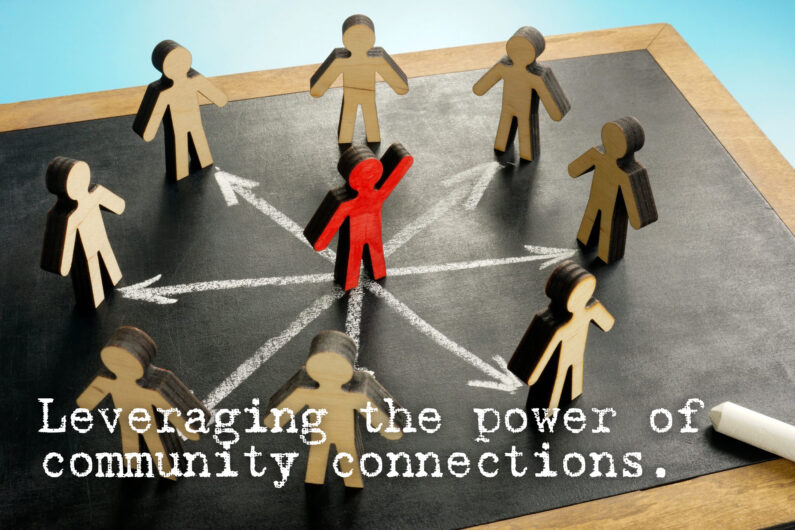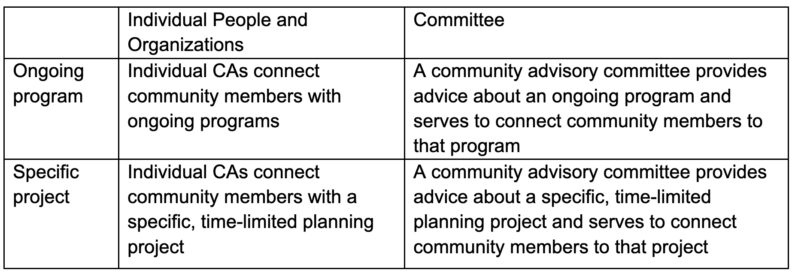A Placemaking Journal
Connecting Communities with Planning: Community Ambassador Programs
We all have a better chance of conducting effective public engagement when we have more tools in our toolbox. One tool that I am seeing in growing use is a community ambassador (CA) program. These programs take different forms, but the core commonality is that they empower community members, rather than professional planners, to serve as ambassadors to connect people with planning efforts.

One barrier to effective public engagement is that planners as a group are demographically different than the population as a whole. According to census data, professional planners are more likely to be white, male, and with higher levels of education than many communities they work in. On top of that, many neighborhoods have a distrust of planners and the government due to past experiences with urban renewal, highway construction, siting of toxic or undesirable land uses, and gentrification. The disconnect from these two forces—demographic differences and historical experiences—can make it difficult for professional planners to reach local community members. To address this divide, some government agencies are hiring local community members or nonprofit organizations, usually on a part-time basis, to serve as “ambassadors” to build connections between planning efforts and people in neighborhoods.
Community Ambassador Program Variations
This post will introduce the four main types of community ambassador programs and discuss their specific applications.

Community Ambassador (CA) programs vary in whether they use individual Community Ambassadors versus a community advisory committee and whether the CA effort is geared towards ongoing programs or specific, time-limited planning projects.
The City of Philadelphia is using every type of community ambassador program to augment its public engagement efforts. With the city’s Vision Zero Ambassador program, community members get paid to provide information about the city’s various Vision Zero efforts at community events and festivals, neighborhood meetings, churches and community centers, and by doing door-knocking in the neighborhood. Similarly, the Indego bikeshare program has Indego Ambassadors that organize group rides and other events to help community members learn about the Indego program and to help Indego leaders learn about community needs. Both of these are examples of ongoing programs with individual people as community ambassadors.
The city also used a similar approach for a specific, time-limited project, the Lehigh Avenue Safety Improvements Project, where community members were hired to provide information about the project at community events, conduct door-knocking to promote project meetings and surveys and collect input from residents, and to provide their own advice about how to align the goals of the project with the goals of the community. The Lehigh Avenue Safety Improvements project ambassadors included both people hired as individuals as well as community organizations contracted to provide ambassador services. The city is now gearing up for conducting a substantial revision to its citywide comprehensive plan. One core element of the city’s plan for public involvement is their call for Community Partners, who will receive funding to help residents share their stories, imagine the future of the city, and work with the Philadelphia City Planning Commission to develop ideas on how to achieve their goals. They will also take a specialized Citizens Planning Institute course to learn about comprehensive planning and strengthen skills in data collection and analysis. With support from City staff, Community Partners will host community engagement activities, help shape the final Plan, and share back what they learn.
These previous examples demonstrate variations on hiring individuals or organizations to conduct ambassador work, either for an ongoing program or a time-limited planning effort. Another model brings together community ambassadors into an advisory board or committee. In addition to their Indego Ambassadors, Indego also hosts the Indego Community Advisory Council (ICAC), launched in 2024 following the release of the Indego Equity Plan. The purpose of the ICAC is to provide a platform where trusted partners who represent marginalized communities can influence decisions in a way that addresses the needs of the communities they serve. Indego sees this group as a core foundation of their equity work and credits the council with helping Indego extend their reach in marginalized communities.
Finally, the City’s Eastwick Flood Strategy project used a Community Council, a standing advisory committee, to have a way to engage with a stable set of residents who attended monthly meetings and built up a repository of knowledge about the project. The Eastwick Community Council also provided advice to the project team about public workshop formats, displays, and language to make them more accessible to community residents. Finally, Eastwick Council members acted as direct ambassadors to the community by hosting their own “Chat & Chew” meetings (aka Meetings in a Box) to get resident input in a casual, more intimate setting.
Benefits of Community Ambassador Programs
There is something invaluable about having people who know and understand the local community doing this work—Community Ambassador programs have numerous potential benefits.
Neighborhood dynamics: CAs understand local dynamics, neighborhood safety concerns, why people may or may not attend a meeting at a particular time and place, and what other issues people in the neighborhood face. Understanding these dynamics from the inside helps the team design engagement opportunities that with people’s realities.
Events and logistics: CAs hear about community events and know about local meeting spaces that people in the community are comfortable with. One basic principle in community engagement is to go where people are—connecting with existing events helps reach people who would never hear about or attend a meeting on your project. And local meeting spaces each have their own history and constituency—holding a meeting in a place where people do not feel welcome adds a big barrier to participation.
Accessible communication: CAs help city staff get a feel for how community members will react to materials (presentations, surveys, etc.) to be used at a public meeting or other community setting and help staff improve those materials to work better in the specific community. CAs may have language skills (beyond English) relevant to the neighborhood.
Educated input: CAs also provide consistency in having continuity and increased contact with the project throughout all of its phases. In addition to their role connecting other residents with the project, CAs themselves become educated about project issues and can provide their own direct input from this more educated place.
Connection to other resources: CAs provide broader benefits to the community by connecting them with other relevant resources while they are out conducting their program- or project-specific outreach.
Community Ambassador Program Challenges
It’s not all roses, though. Community Ambassador programs have their own challenges. Community Ambassador programs of any form require resources and time to set up and run.
Recruitment: The ideal Community Ambassador has deep connections in the neighborhood, is well-known and respected, has strong communication and organization skills, has some familiarity with the particular planning topic, and has the flexibility to be responsive at different points in the life of the project. Of course, that full set is difficult to find in a short timeframe, so the project manager may have to weigh which qualities are most important. Project Managers also have to be ready to adjust when a CA cannot continue in the role, requiring a transition that lessens project continuity.
Logistics of Payment: Working through the bureaucracy of getting payments to CAs can be challenging. Government agency usually have lots of paperwork requirements even for modest checks. Some CAs may run into benefit cliffs if the CA payment puts them just over the edge for receiving Medicaid or other forms of assistance. It’s important to figure out the specifics early so CAs can get compensated properly.
Measuring Community Ambassador Performance: Community Ambassador work is personal and qualitative, so it is difficult to set measurable performance standards. It’s important to balance conducting appropriate oversight with treating CAs as professionals and giving them some flexibility to maximize the impact of their outreach activity. Setting up a consistent way for CAs to track their work along with community input is crucial for the full team to have insight into CA activities and resulting input.
Recommendations for Starting a Community Ambassador Program
Even with the challenges, the benefits of CA programs make them a good choice for particular circumstances, so I will end with some advice for starting a CA program.
Choose projects carefully: Not every project needs or would benefit from a Community Ambassador program. Due to the time and challenges of recruitment and payment, this tool is not a good fit for a quick or low budget project. In neighborhoods with people who have plenty of disposable time to attend meetings or that have active organized civic organizations, CAs are unnecessary. In communities that have civic associations that are competing or fighting with each other, those organizations are not good candidates for doing Community Ambassador work, and it would be important to understand the affiliations of any potential CA recruits. CAs in that situation should either be unaffiliated with the competing organizations or evenly balanced between them. In contrast, projects that may have controversy, where elected officials will need strong confidence in their decision, can benefit from having this extra level of engagement and outreach.
Start early and choose ambassadors carefully: Recruitment of ambassadors and working through bureaucratic payments systems are both challenging and time consuming. One promising technique for recruitment is to identify someone who is already engaged in civic activity in the community as a volunteer advocate or staff in a community facing organization. For community advisory committee or community council models, it’s important to make sure the range of perspectives in the community is well represented on the council.
Include other resources in CA training: CA program can have benefits to the community in terms of connecting people to other social service resources. Program organizers can build this benefit into any project CA effort by simply including some training on key social service resources that are likely to be needed in the particular neighborhood. Then when CAs are tabling an event, attending a community meeting, or doorknocking, they can offer resources as well as ask for people’s input.
Leverage ambassador engagement: In addition to the value that CAs bring to a project conducting outreach work, they also bring ongoing connection to people who know and understand the neighborhood. Program organizers can leverage the value of CAs by treating them as an additional source of advice and input. Consider ways to bring CAs together on some ongoing basis so that they like can feel their connection to the project and each other more clearly, learn more about the technical project material, and serve as an additional source of input from people who understand the project on a deeper level.
Now that you’ve had this overview of community ambassador programs, maybe you have your own ideas for projects or programs that could benefit from this tool? Let’s chat!
Resources to Learn More
The Drink Philly Tap program developed a Guidebook on Creating Ambassador Programs with lots of useful questions and suggestions.
The Camden Coalition Community Partners Toolkit is for partnerships in the health space, but it has lots of good advice that is applicable to urban planning as well.






